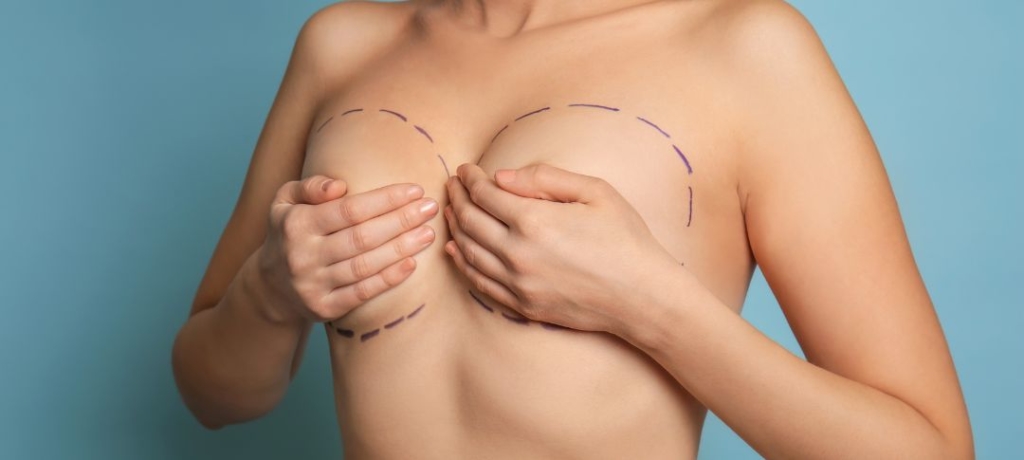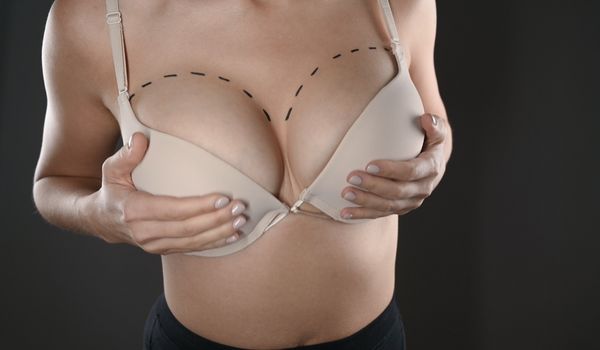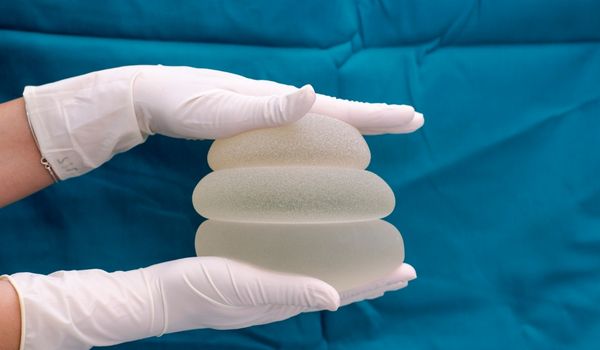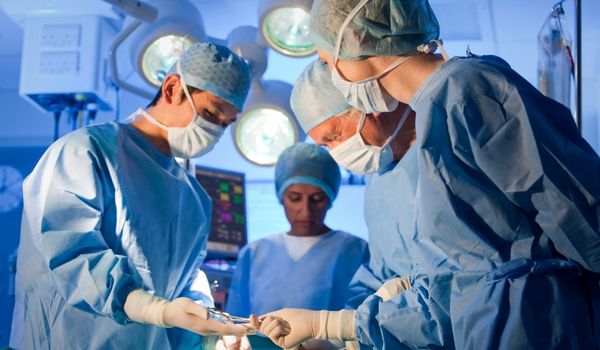
Causes, Treatment and Prevention of Double Bubble Deformity
Double bubble deformity is a complication that can occur when the breast implant descends below the inframammary fold. It’s a common problem after breast augmentation or breast reconstruction with submuscular implants.
It’s believed that most of these cases happen due to the separation of the inframammary fold from the chest wall during breast augmentation surgery. Other risk factors include short nipple-to-fold distance, tuberous breasts, and weak breast tissue.
To repair the appearance of double bubble breasts, surgeons can perform breast revision surgery or fat grafting. Careful preoperative planning can help surgeons reduce the risk of a double bubble complication.
Find out more about this breast deformity, what causes it, how to fix it, how to avoid it, and how it’s different from bottoming out.
What Is Double Bubble Breast Deformity?
A double bubble is a breast contour deformity that happens when the breast implant drops to a position lower than the breast inframammary fold (the natural lower boundary of the breast).
It’s a potential complication following breast augmentation or reconstruction surgery with submuscular (under the muscle) breast implants.
When the implant descends to a position lower than the breast fold, it forms a second crease at the bottom of the breast. As a result, the breast will have two parallel folds across the lower pole of the breast. The folds look like two bubbles, one on top of the other, creating a deformity.
Natural breast tissue from the original breast crease creates the top bubble, whereas the implant creates the one at the bottom.
What Causes a Double Bubble Deformity?
A double bubble deformity is caused by an implant sliding down to a position lower than the natural breast fold. It can happen only weeks after surgery and sometimes even years after breast implant surgery.
Several factors can contribute to the appearance of a double bubble breast, such as:
1. A surgical error
The detachment of the inframammary fold during breast augmentation surgery is considered one of the most common causes of double bubble deformities.
During a submuscular breast implant surgery, surgeons usually make an incision in the breast crease or just below it. Then, they pull away the pectoral chest muscle to create a pocket for the implant beneath it.
In some cases, surgeons accidentally dissect through the breast inframammary fold and release it from the underlying chest wall. As a result, the inframammary fold becomes detached at the bottom of the breast. The implant loses the support usually provided by the breast-fold ligaments at the bottom and begins to descend lower than its original position.
2. Implant size
Some double bubble cases are the result of big breast implants. The right size for breast implants depends on several factors, including how much natural breast tissue the patient has and other characteristics.
In some cases, implants that are too big for the patient’s breasts are used to achieve a significant augmentation. As a result, the patient’s natural breast tissues might be unable to support the heavy implants, so the implants begin to slide down. Which eventually results in a double bubble appearance.
3. Capsular contracture
In other cases, a tight band of thick scar tissue (capsular contracture) forms around the bottom of the breast implant and pushes it too far forward. As a result, the implant bulges out from the bottom, producing this effect.
4. Patient’s anatomy
Even with the most experienced plastic surgeon and the best surgical techniques, breast deformities can still occur.
Several genetic factors can increase the risk of a double bubble deformity after breast augmentation surgery, such as:
- A short nipple-to-fold distance: when the breast has a short distance between the nipple and the inframammary fold, the chosen implant may not fit in the lower pole of the breast and would stick out too much from the bottom. Therefore, patients with a short distance between the nipple and the inframammary fold have a higher risk of developing a double bubble breast
- Tuberous breasts: tuberous breasts usually have a constricted breast base and a lack of natural breast tissue. Patients with tuberous breasts who get implants may not have enough breast tissue to support the implant in its place. That can lead to a deformity when the implant starts to descend into a lower position
- Weak breast tissue: some patients naturally have fragile breast tissue. In those cases, the pressure from the implant may cause a rupture in the inframammary fold, and the implant descends through it into a lower position resulting in a double bubble
How Do You Know If You Have Double Bubble Deformity?
A double bubble deformity is characterised by the presence of two parallel folds in the lower breast after breast augmentation surgery.
You’ll notice an extra fold of breast tissue below the nipple, and the implant will sit lower than it used to.
How To Fix Double Bubble Breast Deformity?
This condition cannot correct itself. In most cases, fixing a double bubble breast requires revision breast surgery.
In mild cases, however, some patients are still satisfied with the appearance of the breast despite this effect and choose not to get treatment.
Double bubble deformity treatment options include:
1. Surgical reconstruction
The surgical correction of breasts with double bubble deformity mainly relies on the reconstruction of the breast tissue and changing the position of the implants.
During a double bubble breast revision surgery:
- First, the surgeon removes the submuscular implants
- Then, the breast tissue of the inframammary fold is repaired and the chest muscle wall is reconstructed
- If there is capsular contracture, the surgeon can correct it by scoring (a procedure that uses heat from an electric current to eliminate the scar tissue
- Finally, the same implants or new smaller ones are placed above the chest muscle rather than under it
2. Fat grafting
Sometimes, fat grafting may be used for the treatment of a double bubble deformity.
The surgeon harvests fat from the thighs, belly, or buttocks. Then, the fat is injected into the breasts without removing the breast implants. The injected fat fills out the space between the implant and the breast fold and creates a smoother breast appearance.
Fat grafting can help reconstruct a double bubble deformity. However, patients may need several fat transfers to achieve the desired results.
How to Avoid Double Bubble Deformity?
Proper preoperative planning helps prevent breast deformity, especially in patients susceptible to this complication. Surgeons must carefully consider implant type, size, and position before breast augmentation surgery.
Surgeons can decrease the risk of double bubble deformity in high-risk patients by:
- Inserting the breast implants in a subglandular position (above the muscle)
- Using shaped implants for patients with constriction at the base of the breast
- Choosing the suitable size and volume of the breast implant based on the patient’s anatomy
Additionally, delicate dissection techniques can help spare the inframammary fold ligaments and avoid a double bubble deformity after breast implant surgery.
Double Bubble Vs Bottoming Out After Getting Breast Implants
Double bubble and bottoming out are both complications that cause a deformity in the breast contour following breast augmentation surgery.
A double bubble deformity is a problem caused by the displacement of the inframammary fold when the implant slips down. The implant drops below the breast crease, and the breast crease rides up the lower pole of the breast, creating a double bubble.
On the other hand, bottoming out happens because the implant stretches out the breast skin with time. As a result, the skin between the nipple and breast fold becomes stretched, and the nipple-to-fold distance increases. In this case, unlike with a double bubble deformity, the breast fold stays in place and is in its correct position.
Patients can develop a double bubble breast deformity after getting breast implants under the muscle. However, an experienced plastic surgeon realises the risk factors of this potential postoperative complication and can take the proper precautions to reduce its risk.
Medical References about Double Bubble Deformity after Plastic Surgery
- The Double-Bubble Deformity: Cause, Prevention, and Treatment… : Plastic and Reconstructive Surgery
- The Supra-Inframammary Fold Approach to Breast Augmentation: Avoiding a Double Bubble – PMC
- The double-bubble deformity: cause, prevention, and treatment
- History of Breast Implants and Breast Enlargement Surgery by Dr Carmen Munteanu
- Breast Implants Perth | Breast Augmentation
- What Is the Best Breast Implant Placement?
- Do You Have Tuberous Breasts? Here’s How to Fix Them



